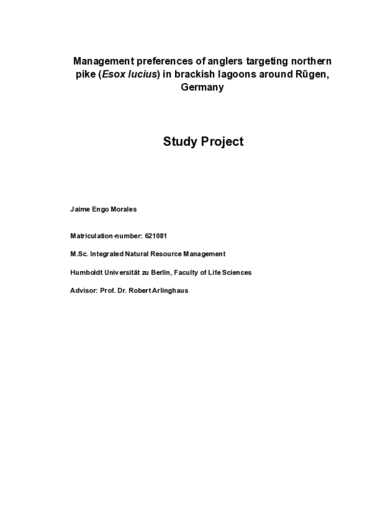In this study, I investigate the management preferences of anglers targeting northern pike (Esox lucius) in lagoon fisheries. The study addresses the issue of declining coastal pike populations in the Baltic Sea, particularly around the Rügen lagoons, due to overharvesting, habitat loss, and predation, which have led to conflicts between commercial and recreational fisheries. The objective is to assess angler preferences for management measures, examine differences between resident and tourist anglers, and explore how individual characteristics influence these preferences, providing insights for sustainable and socially acceptable fisheries management strategies. Drawing on open-ended survey data collected online from N = 946 coastal pike anglers, I used content analysis of narrative answers and derived management tools suggested by anglers. The most frequently mentioned management measures to support the pike fishery were implementation of harvest slot-length limits (55.5% of responses) and other harvest limits (39.6%), followed by seasonal closures (25.3%), enforcement and control measures (23.5%), and effort control for commercial fisheries (9.1%). The focus on supporting the fishery through harvest constraints agreed with earlier research on the same angler group, implying a concern by anglers that current fishing mortality is excessive and the abundance of trophy pike is of concern. Alternative measures to support pike, such as via stocking and habitat enhancement, were infrequently mentioned (1.5% and 0,8%), which disagreed with previous research on freshwater anglers who often believe in stocking to increase pike stocks. Angling tourists and residents varied in their preferences: tourists placed a greater focus on input control measures, such as seasonal closures (28.1%), than residents (19.3%), while residents prioritized improved enforcement (32.4%) and management of natural predators (11.4%) to a greater extent than tourists (19.3% and 5.0%). Increasing harvest constraints on fishing mortality and measures to support large, trophy pike would be largely supported by coastal pike anglers and likely face limited opposition, especially among tourist anglers. To fulfill expectations of residents, a further focus on improved enforcement and control of fish-eating animals can be recommended.
Management preferences of anglers targeting northern pike (Esox lucius) in brackish lagoons around Rügen, Germany
Studie

Veröffentlicht
: 2024
Erschienen in
: Humboldt-Universität zu Berlin, Leibniz-Institut für Gewässerökologie und Binnenfischerei (IGB) Berlin
